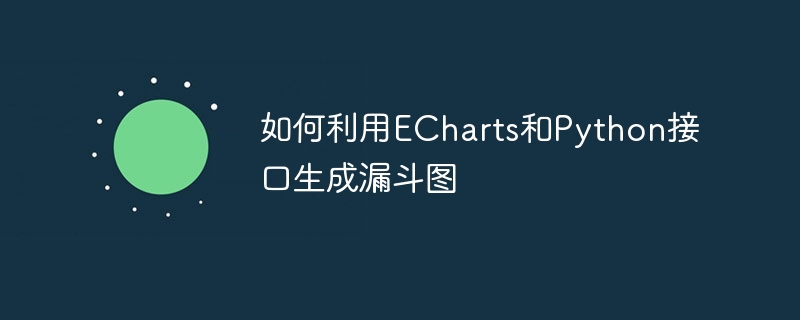

How to generate a funnel chart using ECharts and Python interface
The funnel chart is a common and practical data visualization chart that can visually display the distribution and transformation of data. Rate. Funnel charts are widely used in fields such as data analysis and business decision-making. This article will introduce how to use ECharts and Python interfaces to generate funnel charts, and attach detailed code examples.
ECharts is an open source front-end visualization library that supports a variety of common data visualization chart types, including funnel charts. As a popular programming language, Python has rich data processing and visualization libraries, which can be used in conjunction with ECharts to achieve flexible and efficient data visualization.
First, you need to install ECharts and Python related libraries. It can be installed through the pip package manager and execute the following command on the command line:
pip install pyecharts
Next, we start writing code to generate a funnel chart.
from pyecharts import options as opts
from pyecharts.charts import Funnel
from pyecharts.commons.utils import JsCode
# 创建数据
data = [("步骤1", 100), ("步骤2", 80), ("步骤3", 60), ("步骤4", 40), ("步骤5", 20)]
# 创建漏斗图对象
funnel = (
Funnel()
.add("转化率", data)
.set_global_opts(
title_opts=opts.TitleOpts(title="漏斗图示例"),
tooltip_opts=opts.TooltipOpts(trigger="item", formatter="{a} <br/>{b} : {c}%"),
)
.set_series_opts(
label_opts=opts.LabelOpts(is_show=True, position="inside"),
tooltip_opts=opts.TooltipOpts(is_show=True),
)
)
# 输出漏斗图的html文件
funnel.render("funnel.html")In the code example, we first create a data list, which contains the name of each step of the funnel chart and the corresponding data value. Then, a Funnel object is created and the add method is used to add data to the funnel chart object. After that, we made some global configuration and series configuration of the funnel chart, including the position of the title, prompt box and label, etc. Finally, use the render method to output the html file of the funnel chart.
If you save the above code as a funnel.py file and execute the python funnel.py command, you can generate the html file of the funnel chart.
You can use a browser to open the generated html file to see the visualization of the funnel chart. In a funnel chart, the width of each step represents the corresponding data value, and the number above represents the conversion rate.
Of course, the above is just a simple example. In actual use, more configuration and customization can be performed as needed, such as adding legends, adjusting colors and styles, etc. ECharts and Python interfaces provide rich configuration options and APIs to meet various needs.
To summarize, it is not difficult to generate a funnel chart using ECharts and Python interfaces. You only need to follow the above steps to install the relevant libraries and write the corresponding code. Through data visualization, we can understand the distribution and conversion rate of data more clearly, allowing us to make more accurate decisions.
The above is the detailed content of How to generate a funnel chart using ECharts and Python interface. For more information, please follow other related articles on the PHP Chinese website!




